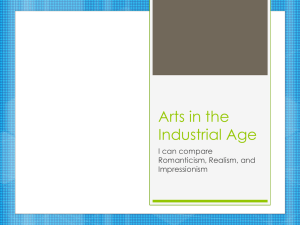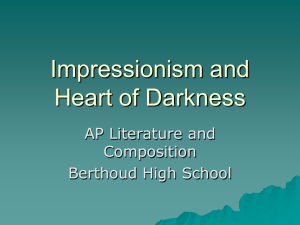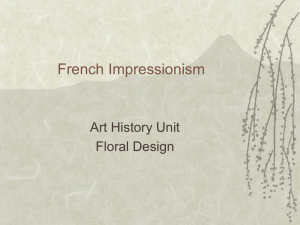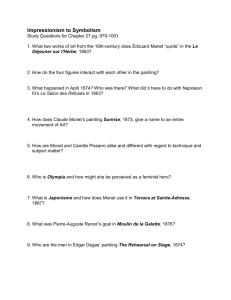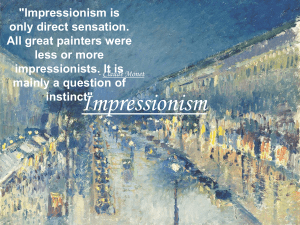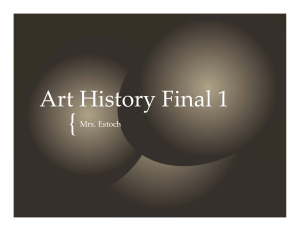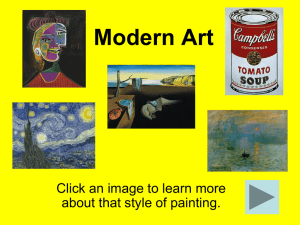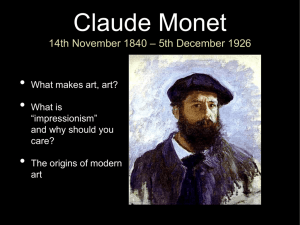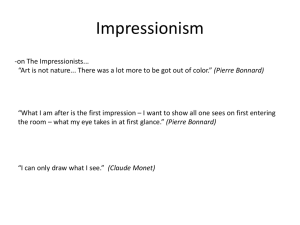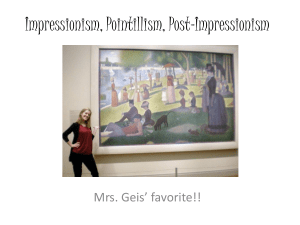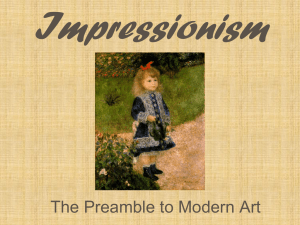Impressionism and Heart of Darkness
advertisement
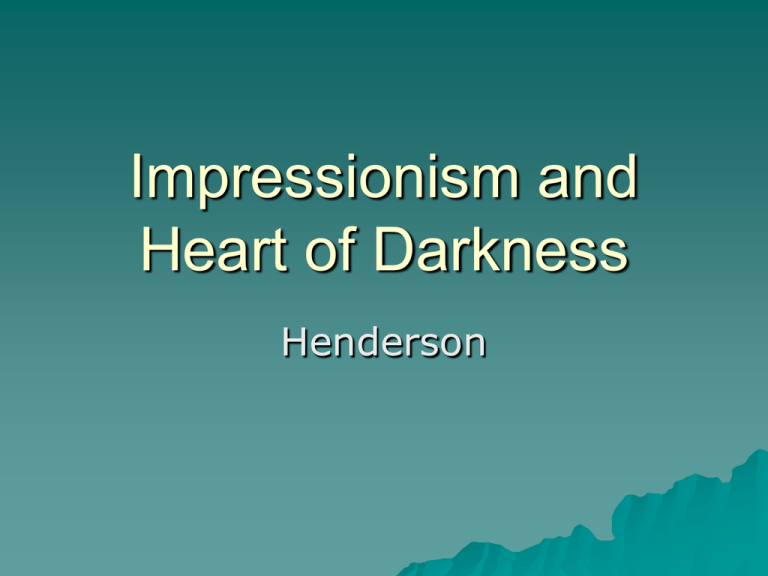
Impressionism and Heart of Darkness Henderson “Impressionism” coined in 1874 by a journalist, Louis Leroy, in an attempt to ridicule Monet’s Impression: Sunrise and other poems on display in the Paris Salon. “They are Impressionists in the sense that they reproduce not the landscape but the sensory perceptions it evokes.” When viewing this painting, how do you feel? What draws your eye? Monet, Haystacks Patterns and themes Landscapes and cityscapes Focus on haze, mist, effects of light Shimmering light, air Portrayal of everyday modern life: ballet, cafes, leisure activities on the banks of the Seine Look for said patterns here: Renoir, The Canoeists’ Luncheon …and here: Monet, Westminster on the Thames Changing the narrative - - In impressionism, the paintings seldom tell stories (as opposed to more traditional schools in which a definitive narrative was captured within the painting) Instead, they capture moments, impressions Compare: David, Andromache Mourning Hector Renoir, Moulin de la Galette “When the emphasis is on the individual’s own perception and the object is to depict what the eye sees rather than what the head knows, everything suddenly becomes worthy of being the subject of a work of art – clouds of smoke in a station, a garden flooded with light, boating on the River Seine, a boulevard full of people, or a snow-covered field.” What is the subject of this painting? What draws your eye? Monet, La Gare Saint-Lazare “For the passionate observer, it is an enormous pleasure to dwell among the masses, in the ebb and flow, in the movement, in the fleeting and infinite.” ~ Charles Baudelaire “Nature is always the same, but of its visible appearance nothing remains constant. Our art must give it the sublime attribute of permanence, along with the elements and appearance of all its changes. Art must give it eternity in our imagination. What is behind Nature? Nothing, perhaps. Perhaps everything. ~ Paul Cezanne Anecdotal quotes Manet to Monet: Monet, you’re a friend of Renoir’s. Why don’t you advise him to take up a different career? You can see for yourself that he’s not cut out for painting. Monet, on his critics: “Poor blind idiots. They want to see everything clearly, even through the fog!” Anecdotal quotes Manet: Are you working on anything for the salon exhibition? Cezanne: Yes, a pot of shit. So… How do the principles of Impressionism transfer into literature? In one way or another, all Impressionists made it their aim to give a pictorial equivalent of the visual sensations of a particular individual at a particular time and place. ~ Ian Watt Conrad: art depends, for its success, on an impression conveyed through the senses Stylistic/narrative elements in HoD: 1. 2. 3. Duplication of narrators: places emphasis on perception; makes you look through a glass, darkly Symbolist: the symbols in HoD change both in scale and meaning Impressionist: still lots to say about this part… More elements in HoD: Frequent use of mist or haze Primary narrator warns us that Marlow’s tale will not be centered on, but surrounded by its meaning. One inherent argument in impressionism is that individual sensation is the only reliable source of ascertainable truth. Conrad employs SUBJECTIVE MORAL IMPRESSIONISM. Navigating through the “fog” HoD embodies uncertainty and doubt. It is an exploration of what men cannot know. Reality is essentially private and individual. Another way of seeing: the fog does not obstruct the subject or the meaning; it is an intrinsic part OF the meaning! Delayed Decoding Combines the forward temporal progression of the mind, as it receives messages from the outside world, with the much slower reflexive process of making out their meaning. Ummm, in English, please?... Delayed Decoding Conrad presents a sense impression but withholds naming it or explaining its meaning until later; as readers we witness every step by which the gap between the individual perception and its cause is belatedly closed within the consciousness of the protagonist. (knobs heads) Relationship b/w impressionism and narrative Virginia Woolf: “Life is not a series of gig lamps symmetrically arranged; life is a luminous halo, a semi-transparent envelope surrounding us from the beginning of consciousness to the end.” “The essence of the action is a process of expanded moral awareness.” ~ Watt Be sensitive to the metaphorical implications of light and darkness in the novella! That’s all, folks.
